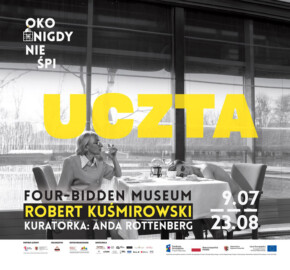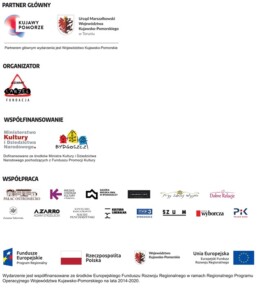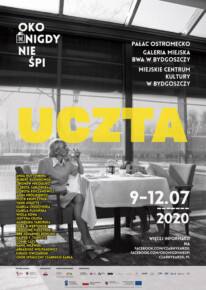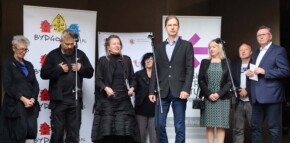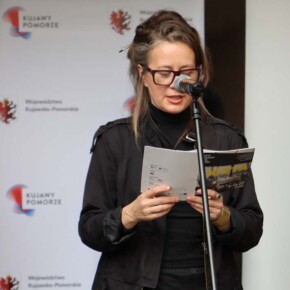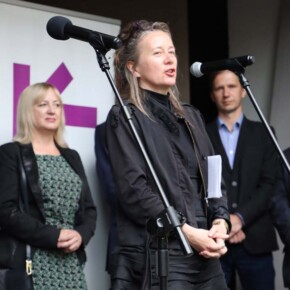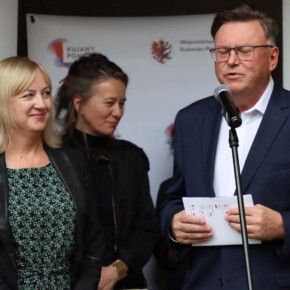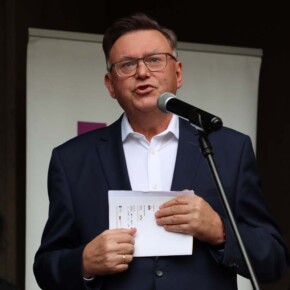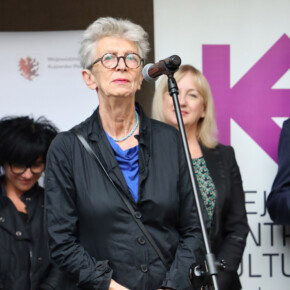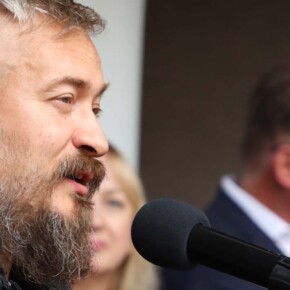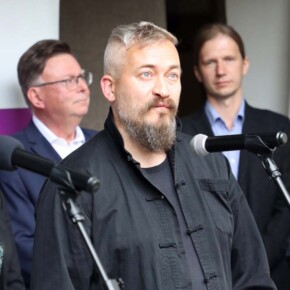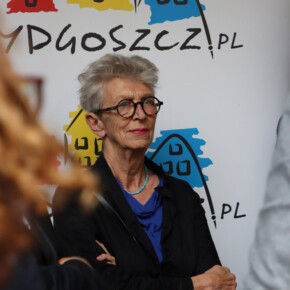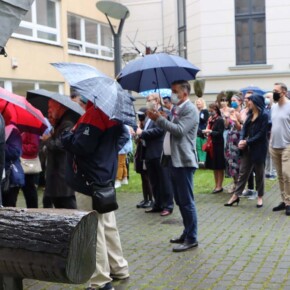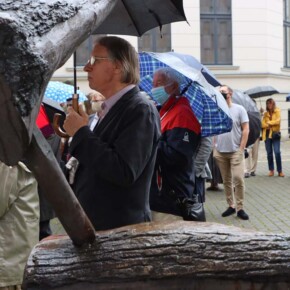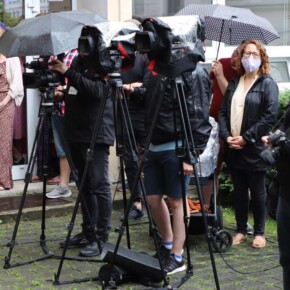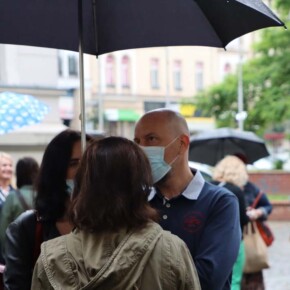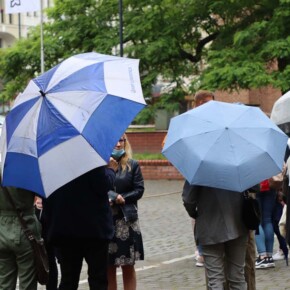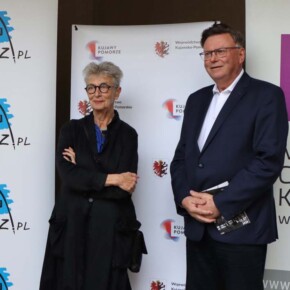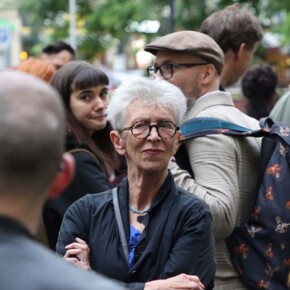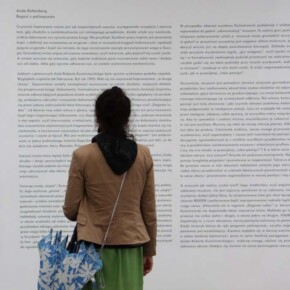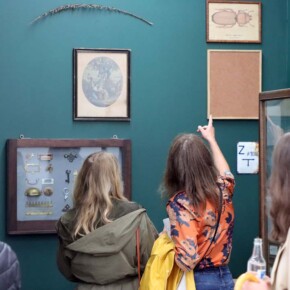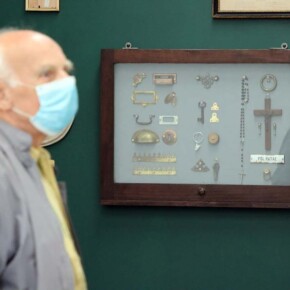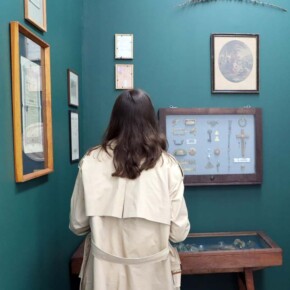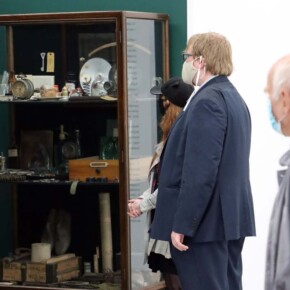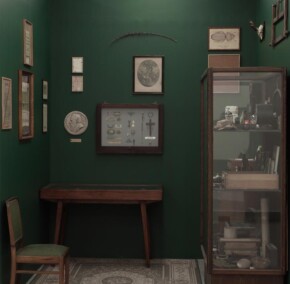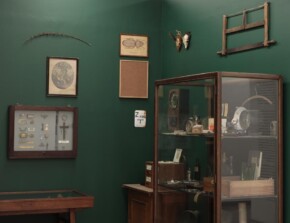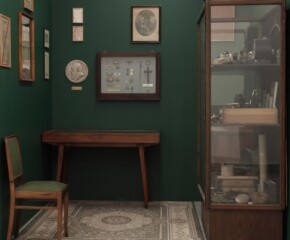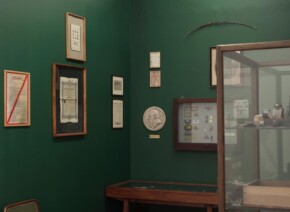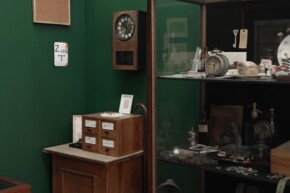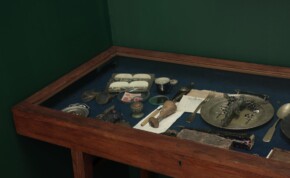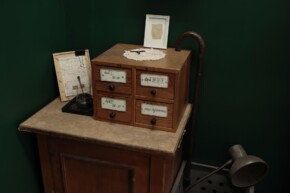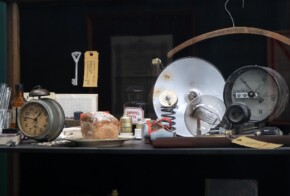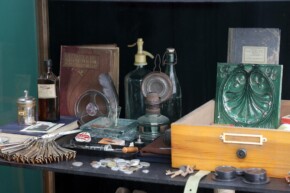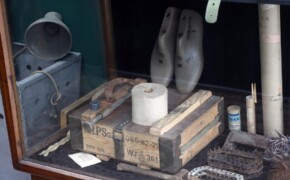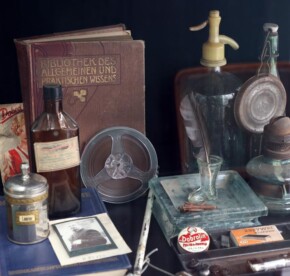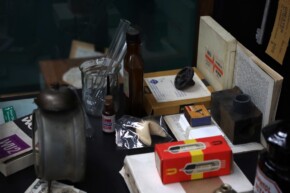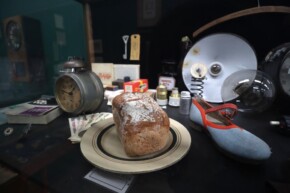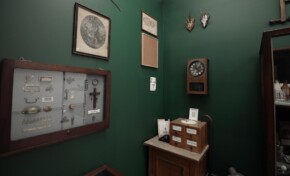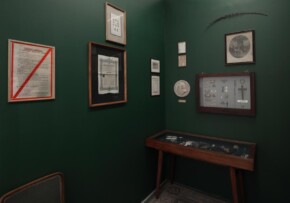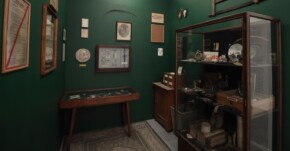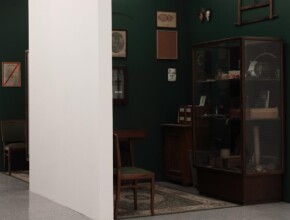Międzynarodowe Spotkania Nieprzypadkowe Oko Nigdy Nie Śpi is a Bydgoszcz festival of visual arts, which this year opens at the Municipal Gallery bwa with Robert Kuśmirowski’s exhibition “Four-Bidden Museum” which is curated by Anda Rottenberg.
Anda Rottenberg
The regest from a palimpsest
The act of copying has been known since time immemorial, it has been present everywhere and always when it was a matter of multiplying an already existing object, a work of art or craft, as well as a document or a hand-written book. For example. The result of the work of a copyist is a copy, by definition not considered original – although in various cultural circles and epochs the notion of an original and a copy did not exist, this distinction began to be given importance in Western Europe more or less since the Renaissance when the art market emerged. And art begins when the copyist goes beyond their limits and adds something from themselves. Or when they manually reproduce something that was produced mechanically.
One of the first works by Robert Kuśmirowski was a hand-made box of matches. It looked just like a factory one. It was 1993. Nobody was involved in copying ‘the other way’. Skills acquired in the school of scriptwriters, who were expected to precisely rewrite books and documents; limners proficient in reproducing illustrations; copyists, faithfully reproducing popular works by outstanding artists, have been forgotten. Now we just watch their production, trying to read and understand the documents. And we catch errors. The historians finding their way through the only founding text on the beginnings of the Polish state, “Dagome iudex,” have long been tearing hair out of their heads, guessing whether mistakes had already been introduced while making copies of this (lost) document, or only at the very end of the 11th century, when a regest, or a summary, or an abstract, which consists of making abridgements without understanding the most important passages. The problem is that the copy also did not survive, and it was then customary for a scribe to make abbreviations in the transcript of certain words and often combine them. It is not impossible that the mysterious incipit “Dagome” is a combination of a double name Dago(bert) M(i)e(szko). The effect of these practices is that it is still not known which Mieszko, the First or Second, issued the original document.
It was different (maybe slightly better) with the equally common practice of creating palimpsests when the scribe – to save on expensive parchment – put new content on the old record, which he usually did not destroy but tried to erase. After centuries, historians can decipher both texts, and often the older one, hiding under the newer one, turns out to be more important.
By creating his “copies,” Kuśmirowski does not directly refer to either of these practices. His numerous “writings,” “books” and “certificates,” as well as large-scale “copies” of various workstations – be it a computer lab from the 1970s or an old shoemaker’s workshop – and various special places (a fragment of a cemetery, a room destroyed by fire, an underground drift) and complicated devices such as a graduation tower (for example), are original works because they do not reproduce reality but create it. And at the same time, they impose a created situation on an existing one in such a way that we are not always able to separate the “semantic layers” created in this way. A perfect example of such an imposition, when we do not know what is signified and what is significant, was his intervention a few years ago in a fenced-off piece of an empty, overgrown with weeds property in Krynki. We do not know which fragments of telegraph poles, cables, scrap metal were “abandoned” by the artist, and which were there before, and whether it was he who tied an old rusty bicycle to the fence or maybe he already found it there.
In the case of the current exhibition, Kuśmirowski plays a slightly different game with the audience. First, he introduces the “reconstruction” of the museum into the gallery. This is an important gesture, because a gallery is traditionally a place to show art, and a museum can gather everything. This conversion of gallery space into museum space is first a creative act because it is realized by the artist’\s decision already at the stage of conception. It assumes that when entering the gallery, the viewer will accept the imagined rules of the “preliminary game,” i.e. they will agree to this occasional exchange and consequently accept the division of space into separate “exhibition rooms,” as they usually agree to such divisions at other exhibitions. However, in accepting this “game of the museum,” they expect to see works of art there. And instead, they see an accumulation of non-artistic objects, like in a typical “exhibition room.”
Of course, the museum is indirectly also a place where the memory carried by the objects is collected, but the set of objects offered here does not correspond to the commonly known patterns, as it does not create a convincing or perhaps coherent visual and conceptual collection that fits into the habits of the recipient. We do not know to whom it is dedicated, whose memory is protected here and what factor forms the basis for selecting the ‘exhibits’. So we are looking for hints in the next room. But it looks just like the first one. After going through the next ones, we realise that all four have the same look. Or similar. To check this and find the differences, we would have to see them at the same time, but exactly that is not possible. We must rely on our memory. Or on the photographs to serve as its surrogates. Whatever we do, our attention shifts from the real object to the imaginary one, that is, the remembered one – even if the memory carrier is a photograph. So, are the designata of the objects collected here with great effort secondary in nature, and the focus of the museum and the actual profile of the collection is our memory? And is that not what the average ‘exhibition room’ is about? Then what is the old text and what is the new text in this palimpsest? The artist does not suggest a solution. He presents us with a rebus, proposes juggling with concepts, and leaves us in uncertainty. Also, as regards the role of the spectator in his work. After all, our presence in it radically changes its interpretation. For four similar collections of objects in four identical spaces are something different from the same collections and spaces nested in and marked with our memory.
Finally, how should the title be understood? Its source, the English FORBIDDEN MUSEUM, is not logical because what is forbidden cannot be accessible. But it is enough to add a single letter for the proposed wordplay here combining the word FOUR (four) with the word BIDDEN (offered or proposed) to make sense. Or at least more sense. Unlike in the ‘Dagome iudex’ regest, in which letters were rather subtracted. Kuśmirowski also does not fully explain the meaning of the title. He only imposes it on another notion, which does not disappear; both, or rather one on top of the other, FOUR-BIDDEN on FORBIDDEN completes what we are dealing with: our memory imposed on the memory of objects.
When a historian takes a palimpsest parchment in his hand, he usually reads a newer record first because it is clearer. And then he delves into the older layer. It is less readable and therefore more mysterious and, as such, more attractive. If we look closer at the whole of Robert Kuśmirowski’s work, we will also see this erased, forbidden area that overshadows our perception of reality.
Robert Kuśmirowski – artist, performer, creator of installations, objects, photographs, drawings. He studied at the Faculty of Art of the Institute of Fine Arts at Maria Curie-Skłodowska University in Lublin, where he received his diploma in the studio of Monumental Sculpture of Prof. Sławomir Andrzej Mieleszka. Scholarship holder at the Metal and Modelling Workshop of the University of Rennes 2 and BeauxArts Rennes. Associated with the Foksal Gallery Foundation in Warsaw, Johnen Galerie in Berlin, Guido Costa Projects in Turin. Most of his works are based on reconstructing and copying old objects, documents, photographs, or rather on creating their deceptively similar imitations. Usually, they do not have their specific prototype, but only evoke the material culture of a certain era. However, they are always characterized by obsessive accuracy and meticulousness. Larger installations also reveal the artist’s passion for collecting. In this way, Kuśmirowski refers to the memory, history and nostalgia that accompanies visual culture from the distant and slightly closer past slowly disappearing underneath. Thanks to this, his works also reveal a vanitative theme – the recreation of a bygone material culture becomes a way of dealing with the subject of short term, transitoriness and death. His actions and performance activities are similar, sometimes supplemented by the music he composes. The problem of the passing of time should be regarded as one of the most important threads in the artist’s work. In 2004, he was nominated for the Paszporty Polityki award, and in 2005, he won this award in the visual arts category. He has taken part in exhibitions in Poland and abroad. Called “genius of dummies,” “brilliant imitator.” Curator and organizer of many art exhibitions.
Anda Rottenberg – graduated in art history from the University of Warsaw. Active critic since 1966. Articles and essays published in most European languages, as well as in Japanese and Korean; wrote such books as “Sztuka w Polsce 1945-2005”, 2005; “Przeciąg – teksty o polskiej sztuce lat 80”, 2009; “Proszę bardzo”, 2009; “Już trudno (wywiad Doroty Jareckiej)”, 2014; “Berlińska depresja”, 2017; “Lista”, 2019; numerous monographs and albums on Polish and foreign artists.
Since 1980, she has been a curator and co-curator of some hundred Polish and international exhibitions, among others I Kwanju Biennale, South Korea; Aspects-Positions 1949-1999, 50 Years of Art in Middle Europe (Vienna-Budapest-Barcelona-Birmingham 2000); L’Autre Moitie de l’Europe (Galerie Nationale du Jeu de Paume 2000/2001, Paris); Where is Abel, Thy Brother, Zachęta Gallery, Warsaw, 1995; Forgetting, Weseburg Museum, Bremen, 2000; Continental Breakfast, Belgrad 2004; Warszawa/Moskwa-Moskwa/Warszawa, Zachęta Gallery Warsaw/Tretiakowskaya Gallery Moscow, 2004/2005; Obok. Polska-Niemcy, 1000 lat historii w sztuce, Martin-Gropius-Bau, Berlin, 2011; Void, Nowy Sącz, 2012; UNI/JA-UNI/ON, Lublin 2013; Postęp i higiena, Zachęta Gallery, Warsaw, 2014/2015; Perspektywa wieku dojrzewania, Muzeum Śląskie, Katowice, 2018
Commissioner of the Polish Pavilion at the Venice Biennale of Art 1993–2001; curator of Polish participation in the Sao Paulo Biennale 1997; 2001; 2004; 2008
Academic work at the PAN Art Institute 1973-1986. Founder of, among others, EGIT Foundation (1986), Soros Center of Contemporary Art, Warsaw (1992), Instytut Promocji Sztuki Foundation (1995). Director of Zachęta – National Art Gallery in Warsaw (1993-2001), Chairperson of the Programme Council and Programme Director of the Museum of Modern Art in Warsaw (2005-2007).
Teaching work at the Jagiellonian University, the University of Warsaw and the Academy of Fine Arts in Warsaw. Visiting lecturer: Bard College, USA; Aalto University, Helsinki, Kunstakademie, Munich.
Member of the Board of the Manifesta 1 Foundation; Member of the Selection Committee for the Position of the Director of Documenta 12. Member of international associations: AICA, CIMAM, IKT.
Fellow Wissenschaftkolleg zu Berlin 2015/2016
Currently, she acts as an independent author and curator.
Since 2012, she has been running her own programme Andymateria on TOK FM radio.
Since 2017, head of the culture department at Vogue.pl.
Beginning of the exhibition 09.07.2020, 6 pm
20 Gdańska St.
End of the exhibition: 23.08.2020


